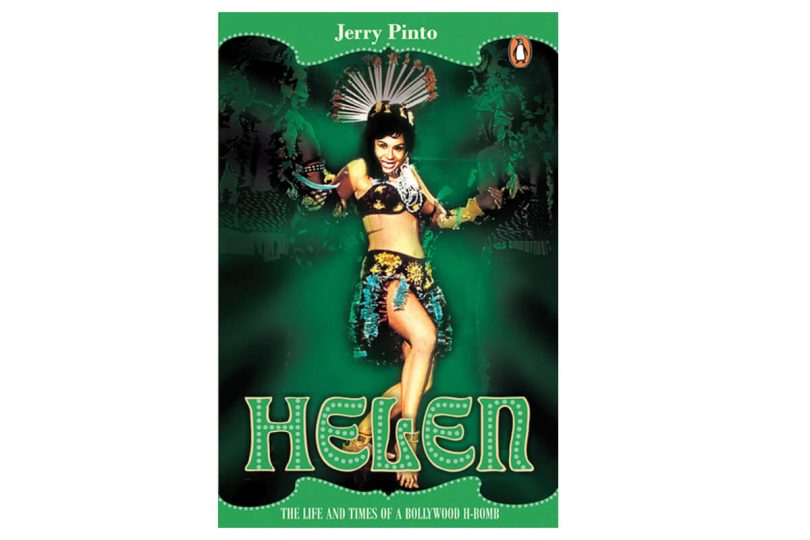She may have retired from films as an actress but the ‘Helen effect’ that changed the Indian film industry for the better hasn’t died down despite the passage of time. Her ascent from a dancing girl to an award-winning actress proves that talent is all you need to succeed, and Bollywood dancing girl turned actress Helen had loads of it. Author Jerry Pinto’s book Helen – The Life and Times of a Bollywood H-bomb tells you all there is to know about the girl who carried the vamp torch in Bollywood for multiple decades and seduced multiple generations onscreen, without losing her popularity.
The first question that comes to mind after reading the name Helen is – is that her original name or one for the stage? According to the author, Helen’s name is as original as the French and Spanish-Burmese connection she brought to the Indian film industry. He discusses her journey from a youngster who lost her stepfather in the Second World War and escaped Burma (now Myanmar) to avoid the Japanese occupation with her mother, to her entry into the film industry of India in the first few chapters, captivating the readers in the pure filmi style.
He then discusses Helen’s rise in the film world, which had more to do with her talent and less to do with her genes. She wasn’t the first actress of foreign origin to make it big in India, nor was she the most glamorous in the era of divas, yet she managed to make a name for herself through her dancing skills and ability to engage the audience. According to this book, Helen became so popular as a dancing actress that when she was on top of her game, she brought in audiences who used to leave as soon as they knew Helen wouldn’t return to the screen, such was her popularity.
This well-researched and gloriously penned book is a biography that deals with the phenomenon that was Helen. The author explains her existence in the then and later Bollywood in her own words, using Helen’s past interviews to take the story forward. Not only does her experience of running away from Burma make it to these pages but also her explanation of why she decided to work instead of continuing her studies, and how she made it big in the Indian film industry. Although the author also talks about her countless songs that are to date as popular as they were back in the day and what made them so special, he sometimes uses Helen’s words (from previous interviews) to give them authenticity.
The author must be commended for taking the readers back to the days when Bollywood was establishing itself as an industry. He explains how Helen’s arrival at the right time and at the right place changed the way films were produced, how she became an in-demand commodity, and why every producer wanted to have her in their film. She worked with every big name in her days from Ashok Kumar to Amitabh Bachchan, but according to the book, it was with Shammi Kapoor with whom she produced her best works, since each and every film they did together featured a duet that revolved around the two.
Be it Suku Suku in Junglee, O Haseena Zulfon Wali from Teesri Manzil or Muqabla Hum Se Na Karo from Prince, whenever two of the best dancers in the industry collaborated, the result was electrifying. The duo would captivate the audience with their moves, and their dancing skills and then go on their separate ways after the song or the arc ended. Considering that Shammi Kapoor was the wildest film star in India at that time, matching him made Helen equally wild, if not more.
What was the change that Helen brought with her, you might ask? Before Helen, the song was just part of the film but not part of the story since the dancer wouldn’t be able to register as a character. After Helen, as this book explains, the importance of the song, the item number, and even the ‘other’ woman in Hindi cinema, increased and they all became part of the story. Her ‘foreign looks’ added the mysterious element that wasn’t part of those local girls who might have been better actresses than her but didn’t look alien enough to stand out.
Going through this book, you will realize that there is more to Helen than meets the eye. The factors that made her acceptable to the conservative families of the era also helped her successors who followed her path, during her career or after her retirement. It was Helen who endured the objections of middle-class Indian morality in her heydays and stood against those who didn’t respect the dancing girls of her times. Had she not done that – the author explains – there wouldn’t have been the Madhuri Dixits, the Raveena Tandons, the Malaika Aroras, and others who went the Helen way, because she held the fort for them, and drove the detractors away.
After all, what comes to one’s mind when you hear the song Mera Naam Chin Chin Choo from Howrah Bridge, Mehbooba O Mehbooba from Sholay, Yeh Mera Dil from Don, Yamma Yamma from Shaan to name a few? Only Helen could don the blonde wig and look like somebody from abroad, wear contact lenses and become someone else and adopt a foreign accent to portray a foreigner at will. The author also discloses that while Helen’s dances might seem vulgar to some, they never were since she always wore a layer over her skin to keep it decent.
The book doesn’t forget the struggles Helen had to endure during her career, and the urge to be recognized as the good girl, being on top of her list. She was more than just a song-and-dance gal and had appeared as an actress in more films than her competitors, yet was always categorized as a vamp. To play ‘vamp’ to three generations of men, one had to have skills, and Helen had that in abundance. It was only after her retirement that she was able to play the good mother in films, who doesn’t die in the arms of the protagonist, delivering a clue like she did in most of her films in the 60s and the 70s.
There wasn’t just mystery to Helen the seductress but also to Helen the actress; in this book, Jerry Pinto tries to unravel that mystery and succeeds in a way. Despite the non-cooperation of the subject, he was able to provide a detailed look at her illustrious career, one that saw her win awards for her acting, as well as be the change the industry required. The exact number of films she worked on may never be known, but what’s known is the fact that without Helen, the Indian film industry wouldn’t have been in this position right now.
The one-sided narrative seems to be the book’s only drawback – Helen doesn’t endorse what’s written here while the author doesn’t venture into the personal life territory and limits his reference to her relationship to two people – filmmaker PN Arora and Salim Khan (of Salim – Javed fame) who later married Helen. Besides that, this book is an interesting read since it makes you know about Helen, the girl who changed the way films were made in India, long before it was considered a fashion. That’s why she was the main choice for all directors who wanted her to both draw the crowds and play a character that would be important to the story. It was only after she left the scene that others tried to emulate her in their own way.
This book may also not feature collared photographs of Helen from different films and different eras but that doesn’t seem like a disadvantage here, since Jerry Pinto’s words add that missing colour to the book. He has done a fine job in recreating the Helen mystique in such a way that those who saw her in cinemas and those who watched her on VCR are able to relate to her performances. She might have been the great seductress of Hindi cinema but she wasn’t limited to seducing her co-stars but also her fans for whom there was no world without Helen.







